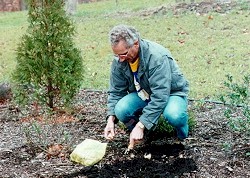AND TOMORROW'S JOYS
|
Late fall has arrived again this year. The brilliance of the fall foliage has had its day in the sun. The multitude of colors rivaled even the greatest of painters, but now the rains have come, accompanied by the precursor of winter, a strong north wind. Those who were dazzled by the hues of reds, oranges, and yellows are settling for the naked trees and lack-luster colors of wintertime. Most of my neighbors are heading inside to find warmth within the walls of their homes. On the other hand, I head outside into the dreary despair of the world of the winds and the smell of snow. I bundle up and head out with shovel in one hand and bulbs from Holland in the other. Why do I wait so long to plant? Finally, Mr. Lee reached down for the last bulb, a daffodil bulb. He told me the variety was called Lively Yellow Radiance. He asked me what I thought of the name? I confessed that I thought it was a dumb name for something that looked so shriveled up. Mr. Lee explained that the bulb represented life. I looked confused; his use of a metaphor was beyond me. Mr. Lee responded like a Confucian philosopher with a statement that I didn't understand at first but later never forgot. "Today's sorrows will give birth to tomorrow's joys." Pulling me gently toward his crouched form, he placed the bulb in my hand and then lifted both the bulb and my hand directly in front of my face. Then, Mr. Lee's lesson of life began in earnest. On that cold late fall day, Mr. Lee talked about how apparently dead and lifeless things like bulbs can live again. He told me that he wanted me to remember this lesson about life. Even though sorrow may abound, don't be discouraged. Joy and happiness will surely return. Then he took my hand holding the bulb and slowly closed my fingers tightly around it. With that he ruffled my hair and told me that I learned an ancient Chinese truth that day. Mr. Lee told me to go home and plant that bulb in my garden, so that when the spring came again, I'd remember his lesson of life.
I've moved away from my home town where I first learned about bulbs and life from a Chinese philosopher. I have lived in several homes since my friend's lesson, but each and every house has had yellow daffodils planted in tribute to Mr. Lee. I'm sure that this fall, when I head out to my flower beds with shovel in one hand and bulbs from Holland in the other, that I'll silently shed a tear of sorrow for my missing friend and thank him for teaching me about life. "Today's sorrows will give birth to tomorrow's joys." I've planted thousands of daffodils in my life, and they have reminded me that life is a lot like the bulb. Sometimes, life seems filled with sorrow or death, but in time new life will emerge with the glow and radiance of the sun. This article first appeared in the Dixon Telegraph
|







 Many
years ago, I lived next to an old Chinese man. I called him, Mr. Lee; his given name was
too difficult for me to pronounce. He was always quiet and unassuming, but when I would
talk to him, he would tell me ancient Chinese wisdom. My planting bulbs late in the fall
came from one of the lessons that he taught me many years ago on a drizzly fall day when I
was very young.
Many
years ago, I lived next to an old Chinese man. I called him, Mr. Lee; his given name was
too difficult for me to pronounce. He was always quiet and unassuming, but when I would
talk to him, he would tell me ancient Chinese wisdom. My planting bulbs late in the fall
came from one of the lessons that he taught me many years ago on a drizzly fall day when I
was very young. Many springs
have come and gone since that cold fall day in Mr. Lee's flower garden in
Merchantville, New Jersey. That winter, Mr. Lee died. However, when spring returned, I
looked for that single daffodil in my garden. Sure enough, as the last snows melted,
Lively Yellow Radiance poked its delicate golden head into the early spring sunshine.
I then
went over to see Mr. Lee's flowers. This time, he wasn't there to greet me, but
they were. They looked even more radiant than ever before.
Many springs
have come and gone since that cold fall day in Mr. Lee's flower garden in
Merchantville, New Jersey. That winter, Mr. Lee died. However, when spring returned, I
looked for that single daffodil in my garden. Sure enough, as the last snows melted,
Lively Yellow Radiance poked its delicate golden head into the early spring sunshine.
I then
went over to see Mr. Lee's flowers. This time, he wasn't there to greet me, but
they were. They looked even more radiant than ever before.